Taxation Law: Analysis of FBT and CGT for Income Year 2019
VerifiedAdded on 2023/03/23
|11
|2271
|73
Homework Assignment
AI Summary
This assignment provides a detailed analysis of Fringe Benefit Tax (FBT) and Capital Gains Tax (CGT) within the context of taxation law. It includes the computation of FBT liability for Spiceco Pty Ltd, considering the car fringe benefit provided to Lucinda, and explores different methods for calculating FBT. The assignment also determines the net CGT gain for Daniel Ray in the 2019 income year, addressing the treatment of CGT gains and losses, and includes a discussion on CGT events, assets, and exemptions, such as main residence and collectibles. The document concludes with detailed calculations and conclusions regarding both FBT and CGT scenarios.
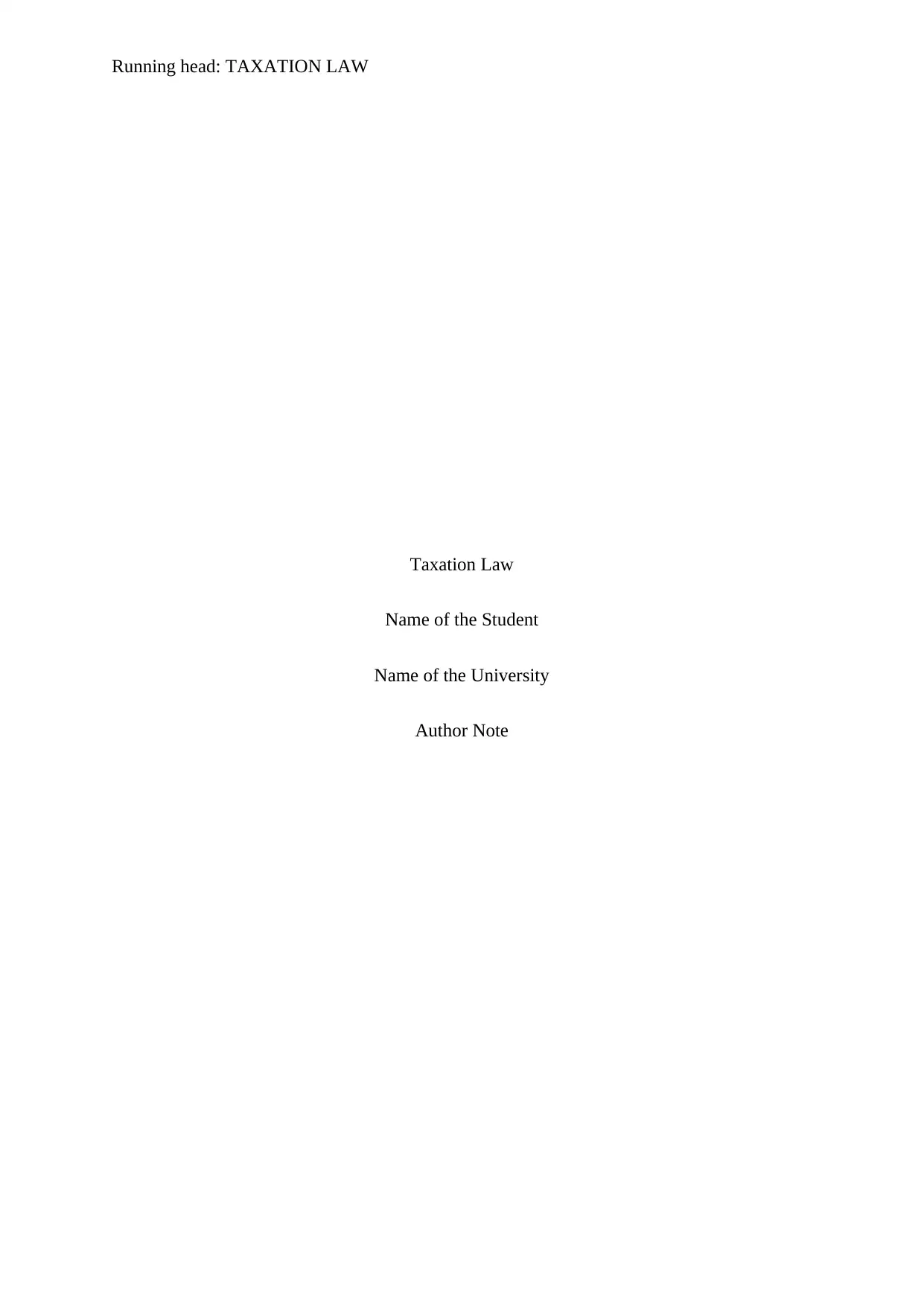
Running head: TAXATION LAW
Taxation Law
Name of the Student
Name of the University
Author Note
Taxation Law
Name of the Student
Name of the University
Author Note
Paraphrase This Document
Need a fresh take? Get an instant paraphrase of this document with our AI Paraphraser
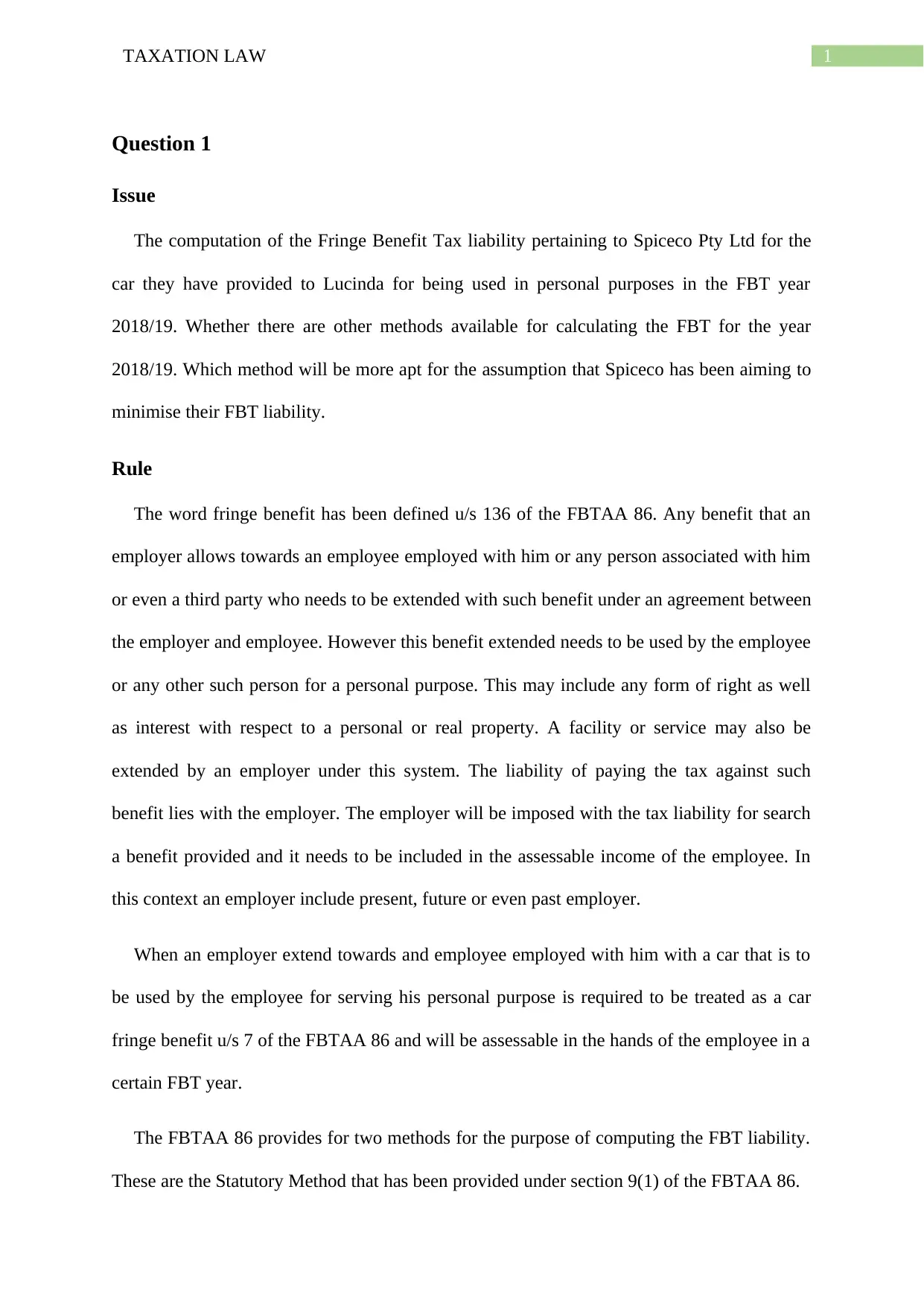
1TAXATION LAW
Question 1
Issue
The computation of the Fringe Benefit Tax liability pertaining to Spiceco Pty Ltd for the
car they have provided to Lucinda for being used in personal purposes in the FBT year
2018/19. Whether there are other methods available for calculating the FBT for the year
2018/19. Which method will be more apt for the assumption that Spiceco has been aiming to
minimise their FBT liability.
Rule
The word fringe benefit has been defined u/s 136 of the FBTAA 86. Any benefit that an
employer allows towards an employee employed with him or any person associated with him
or even a third party who needs to be extended with such benefit under an agreement between
the employer and employee. However this benefit extended needs to be used by the employee
or any other such person for a personal purpose. This may include any form of right as well
as interest with respect to a personal or real property. A facility or service may also be
extended by an employer under this system. The liability of paying the tax against such
benefit lies with the employer. The employer will be imposed with the tax liability for search
a benefit provided and it needs to be included in the assessable income of the employee. In
this context an employer include present, future or even past employer.
When an employer extend towards and employee employed with him with a car that is to
be used by the employee for serving his personal purpose is required to be treated as a car
fringe benefit u/s 7 of the FBTAA 86 and will be assessable in the hands of the employee in a
certain FBT year.
The FBTAA 86 provides for two methods for the purpose of computing the FBT liability.
These are the Statutory Method that has been provided under section 9(1) of the FBTAA 86.
Question 1
Issue
The computation of the Fringe Benefit Tax liability pertaining to Spiceco Pty Ltd for the
car they have provided to Lucinda for being used in personal purposes in the FBT year
2018/19. Whether there are other methods available for calculating the FBT for the year
2018/19. Which method will be more apt for the assumption that Spiceco has been aiming to
minimise their FBT liability.
Rule
The word fringe benefit has been defined u/s 136 of the FBTAA 86. Any benefit that an
employer allows towards an employee employed with him or any person associated with him
or even a third party who needs to be extended with such benefit under an agreement between
the employer and employee. However this benefit extended needs to be used by the employee
or any other such person for a personal purpose. This may include any form of right as well
as interest with respect to a personal or real property. A facility or service may also be
extended by an employer under this system. The liability of paying the tax against such
benefit lies with the employer. The employer will be imposed with the tax liability for search
a benefit provided and it needs to be included in the assessable income of the employee. In
this context an employer include present, future or even past employer.
When an employer extend towards and employee employed with him with a car that is to
be used by the employee for serving his personal purpose is required to be treated as a car
fringe benefit u/s 7 of the FBTAA 86 and will be assessable in the hands of the employee in a
certain FBT year.
The FBTAA 86 provides for two methods for the purpose of computing the FBT liability.
These are the Statutory Method that has been provided under section 9(1) of the FBTAA 86.
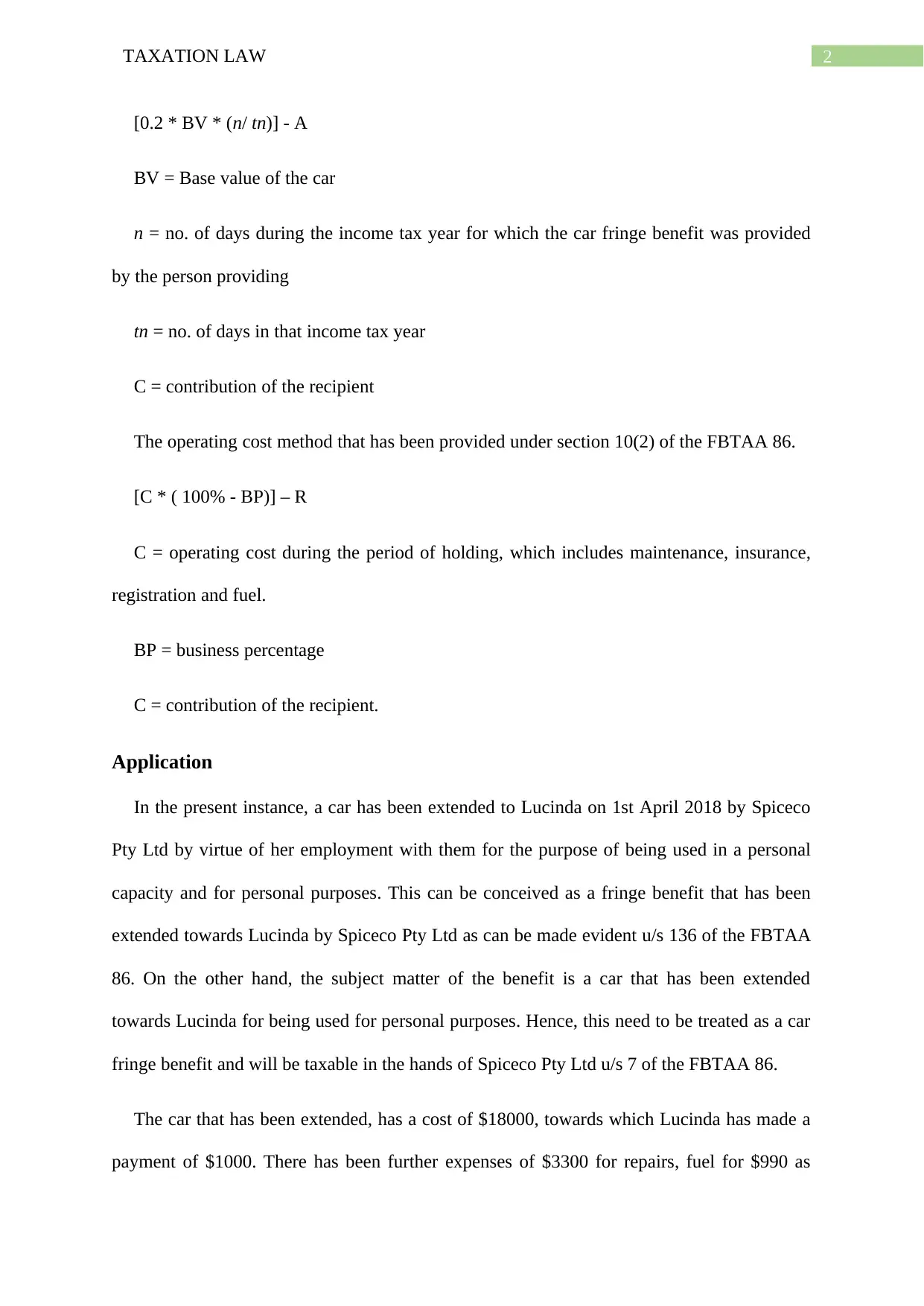
2TAXATION LAW
[0.2 * BV * (n/ tn)] - A
BV = Base value of the car
n = no. of days during the income tax year for which the car fringe benefit was provided
by the person providing
tn = no. of days in that income tax year
C = contribution of the recipient
The operating cost method that has been provided under section 10(2) of the FBTAA 86.
[C * ( 100% - BP)] – R
C = operating cost during the period of holding, which includes maintenance, insurance,
registration and fuel.
BP = business percentage
C = contribution of the recipient.
Application
In the present instance, a car has been extended to Lucinda on 1st April 2018 by Spiceco
Pty Ltd by virtue of her employment with them for the purpose of being used in a personal
capacity and for personal purposes. This can be conceived as a fringe benefit that has been
extended towards Lucinda by Spiceco Pty Ltd as can be made evident u/s 136 of the FBTAA
86. On the other hand, the subject matter of the benefit is a car that has been extended
towards Lucinda for being used for personal purposes. Hence, this need to be treated as a car
fringe benefit and will be taxable in the hands of Spiceco Pty Ltd u/s 7 of the FBTAA 86.
The car that has been extended, has a cost of $18000, towards which Lucinda has made a
payment of $1000. There has been further expenses of $3300 for repairs, fuel for $990 as
[0.2 * BV * (n/ tn)] - A
BV = Base value of the car
n = no. of days during the income tax year for which the car fringe benefit was provided
by the person providing
tn = no. of days in that income tax year
C = contribution of the recipient
The operating cost method that has been provided under section 10(2) of the FBTAA 86.
[C * ( 100% - BP)] – R
C = operating cost during the period of holding, which includes maintenance, insurance,
registration and fuel.
BP = business percentage
C = contribution of the recipient.
Application
In the present instance, a car has been extended to Lucinda on 1st April 2018 by Spiceco
Pty Ltd by virtue of her employment with them for the purpose of being used in a personal
capacity and for personal purposes. This can be conceived as a fringe benefit that has been
extended towards Lucinda by Spiceco Pty Ltd as can be made evident u/s 136 of the FBTAA
86. On the other hand, the subject matter of the benefit is a car that has been extended
towards Lucinda for being used for personal purposes. Hence, this need to be treated as a car
fringe benefit and will be taxable in the hands of Spiceco Pty Ltd u/s 7 of the FBTAA 86.
The car that has been extended, has a cost of $18000, towards which Lucinda has made a
payment of $1000. There has been further expenses of $3300 for repairs, fuel for $990 as
⊘ This is a preview!⊘
Do you want full access?
Subscribe today to unlock all pages.

Trusted by 1+ million students worldwide
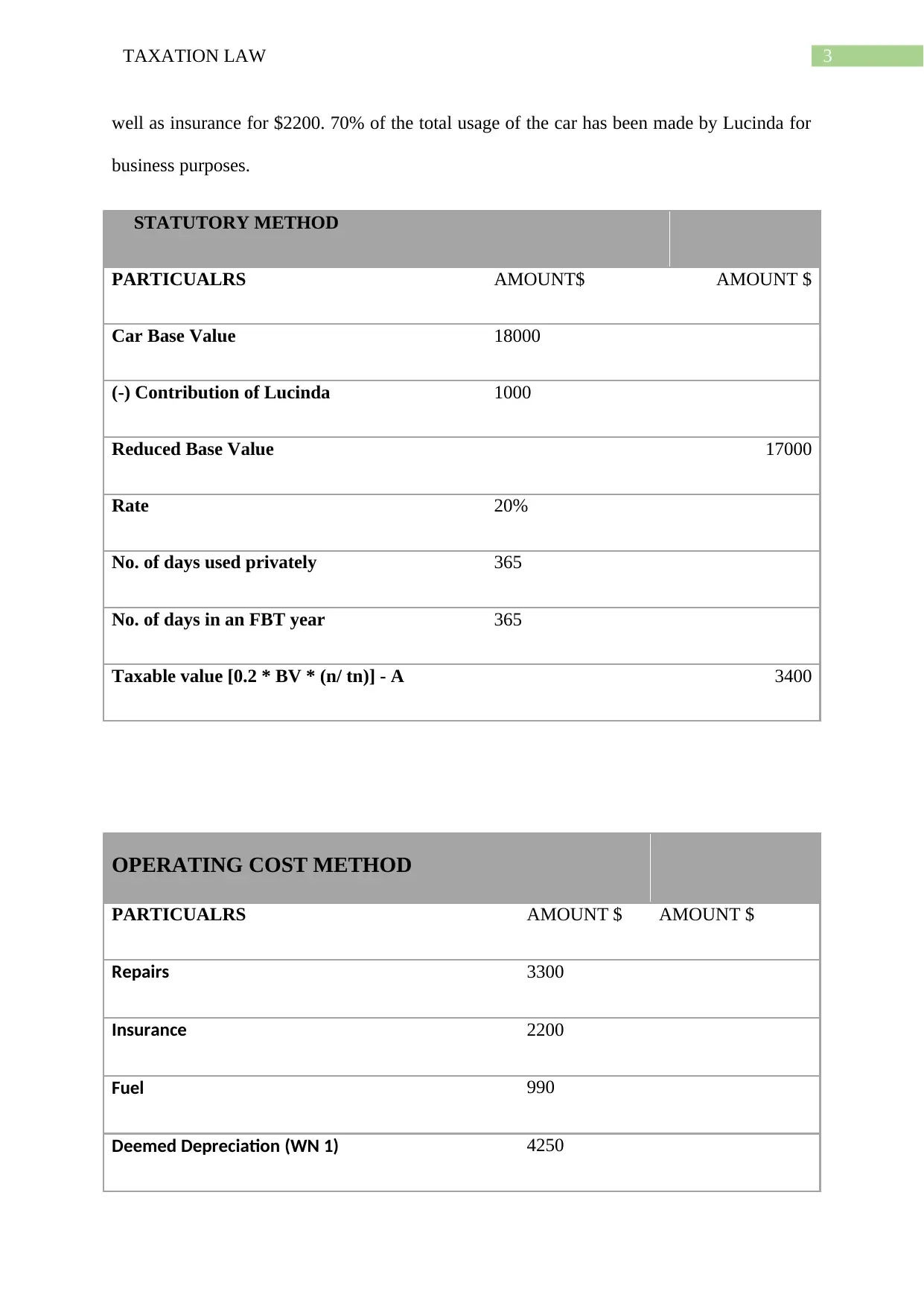
3TAXATION LAW
well as insurance for $2200. 70% of the total usage of the car has been made by Lucinda for
business purposes.
STATUTORY METHOD
PARTICUALRS AMOUNT$ AMOUNT $
Car Base Value 18000
(-) Contribution of Lucinda 1000
Reduced Base Value 17000
Rate 20%
No. of days used privately 365
No. of days in an FBT year 365
Taxable value [0.2 * BV * (n/ tn)] - A 3400
OPERATING COST METHOD
PARTICUALRS AMOUNT $ AMOUNT $
Repairs 3300
Insurance 2200
Fuel 990
Deemed Depreciation (WN 1) 4250
well as insurance for $2200. 70% of the total usage of the car has been made by Lucinda for
business purposes.
STATUTORY METHOD
PARTICUALRS AMOUNT$ AMOUNT $
Car Base Value 18000
(-) Contribution of Lucinda 1000
Reduced Base Value 17000
Rate 20%
No. of days used privately 365
No. of days in an FBT year 365
Taxable value [0.2 * BV * (n/ tn)] - A 3400
OPERATING COST METHOD
PARTICUALRS AMOUNT $ AMOUNT $
Repairs 3300
Insurance 2200
Fuel 990
Deemed Depreciation (WN 1) 4250
Paraphrase This Document
Need a fresh take? Get an instant paraphrase of this document with our AI Paraphraser
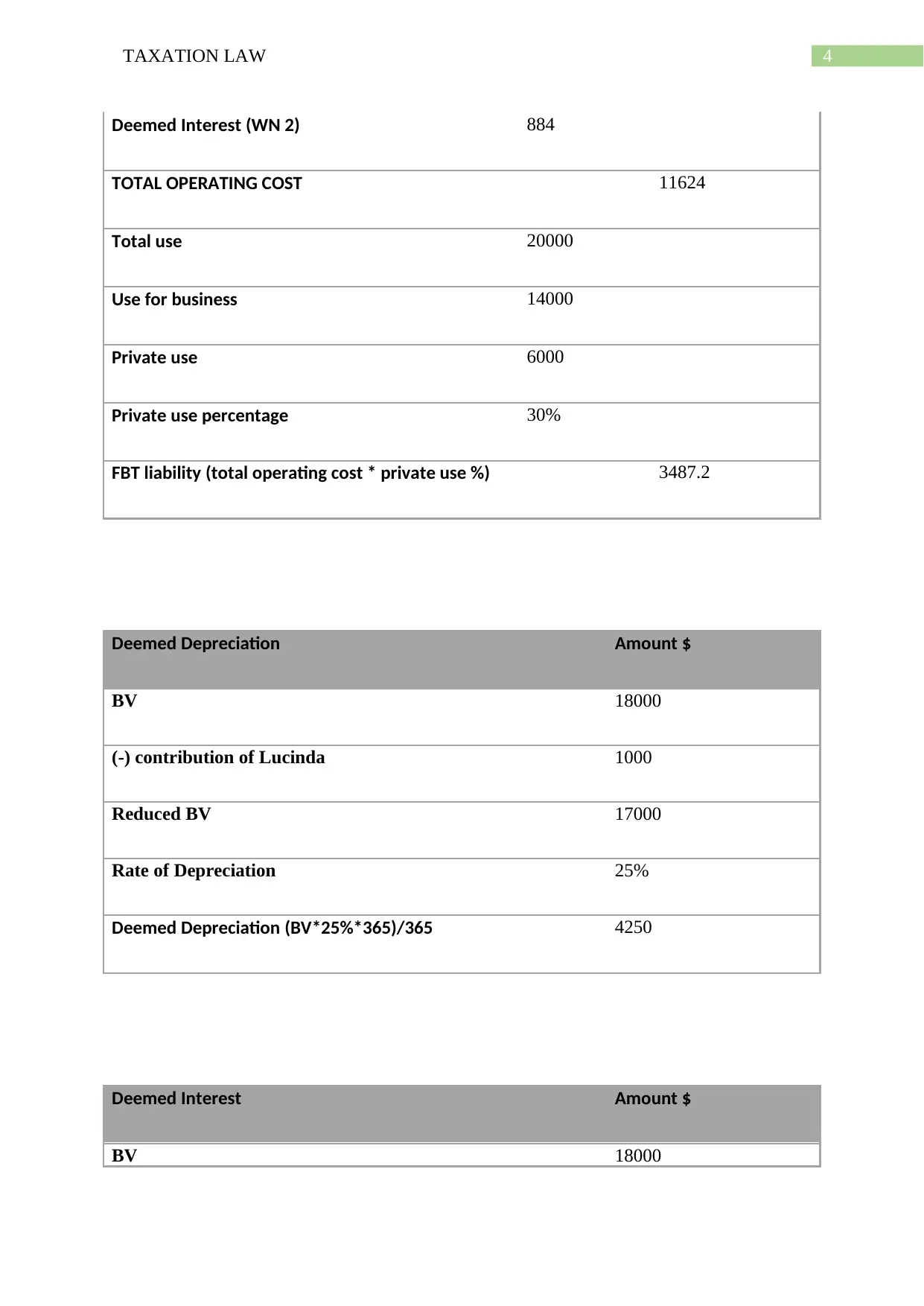
4TAXATION LAW
Deemed Interest (WN 2) 884
TOTAL OPERATING COST 11624
Total use 20000
Use for business 14000
Private use 6000
Private use percentage 30%
FBT liability (total operating cost * private use %) 3487.2
Deemed Depreciation Amount $
BV 18000
(-) contribution of Lucinda 1000
Reduced BV 17000
Rate of Depreciation 25%
Deemed Depreciation (BV*25%*365)/365 4250
Deemed Interest Amount $
BV 18000
Deemed Interest (WN 2) 884
TOTAL OPERATING COST 11624
Total use 20000
Use for business 14000
Private use 6000
Private use percentage 30%
FBT liability (total operating cost * private use %) 3487.2
Deemed Depreciation Amount $
BV 18000
(-) contribution of Lucinda 1000
Reduced BV 17000
Rate of Depreciation 25%
Deemed Depreciation (BV*25%*365)/365 4250
Deemed Interest Amount $
BV 18000
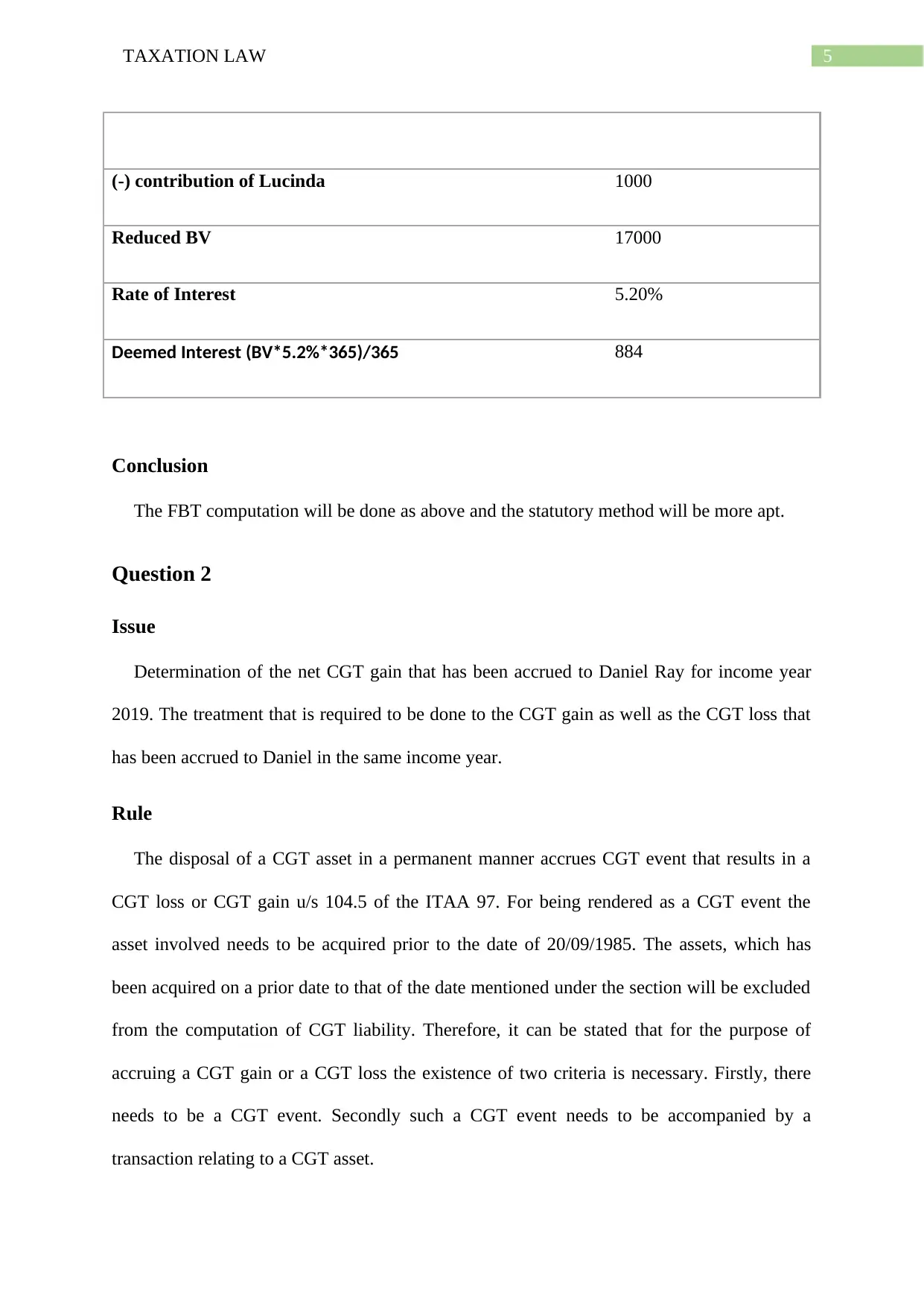
5TAXATION LAW
(-) contribution of Lucinda 1000
Reduced BV 17000
Rate of Interest 5.20%
Deemed Interest (BV*5.2%*365)/365 884
Conclusion
The FBT computation will be done as above and the statutory method will be more apt.
Question 2
Issue
Determination of the net CGT gain that has been accrued to Daniel Ray for income year
2019. The treatment that is required to be done to the CGT gain as well as the CGT loss that
has been accrued to Daniel in the same income year.
Rule
The disposal of a CGT asset in a permanent manner accrues CGT event that results in a
CGT loss or CGT gain u/s 104.5 of the ITAA 97. For being rendered as a CGT event the
asset involved needs to be acquired prior to the date of 20/09/1985. The assets, which has
been acquired on a prior date to that of the date mentioned under the section will be excluded
from the computation of CGT liability. Therefore, it can be stated that for the purpose of
accruing a CGT gain or a CGT loss the existence of two criteria is necessary. Firstly, there
needs to be a CGT event. Secondly such a CGT event needs to be accompanied by a
transaction relating to a CGT asset.
(-) contribution of Lucinda 1000
Reduced BV 17000
Rate of Interest 5.20%
Deemed Interest (BV*5.2%*365)/365 884
Conclusion
The FBT computation will be done as above and the statutory method will be more apt.
Question 2
Issue
Determination of the net CGT gain that has been accrued to Daniel Ray for income year
2019. The treatment that is required to be done to the CGT gain as well as the CGT loss that
has been accrued to Daniel in the same income year.
Rule
The disposal of a CGT asset in a permanent manner accrues CGT event that results in a
CGT loss or CGT gain u/s 104.5 of the ITAA 97. For being rendered as a CGT event the
asset involved needs to be acquired prior to the date of 20/09/1985. The assets, which has
been acquired on a prior date to that of the date mentioned under the section will be excluded
from the computation of CGT liability. Therefore, it can be stated that for the purpose of
accruing a CGT gain or a CGT loss the existence of two criteria is necessary. Firstly, there
needs to be a CGT event. Secondly such a CGT event needs to be accompanied by a
transaction relating to a CGT asset.
⊘ This is a preview!⊘
Do you want full access?
Subscribe today to unlock all pages.

Trusted by 1+ million students worldwide
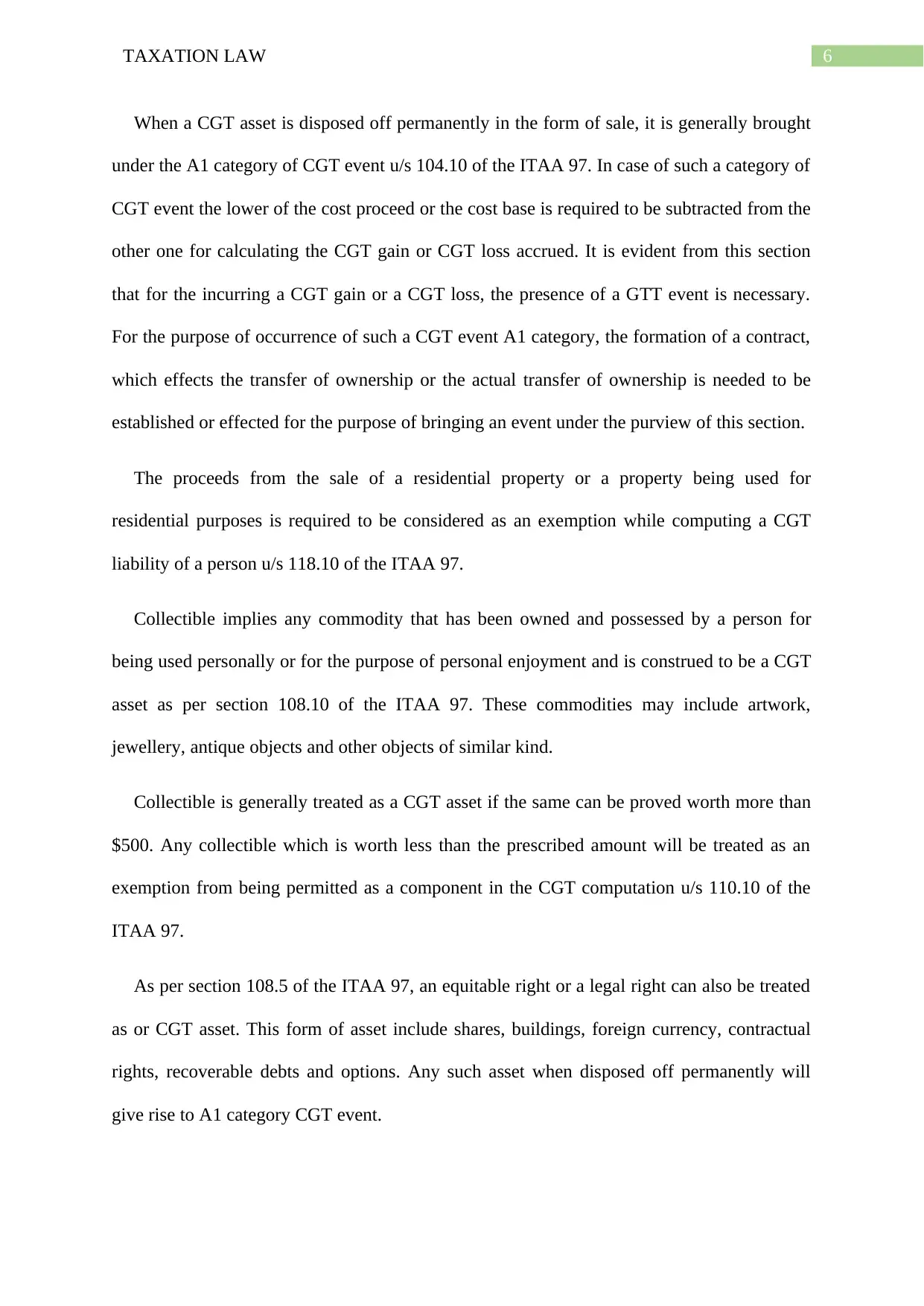
6TAXATION LAW
When a CGT asset is disposed off permanently in the form of sale, it is generally brought
under the A1 category of CGT event u/s 104.10 of the ITAA 97. In case of such a category of
CGT event the lower of the cost proceed or the cost base is required to be subtracted from the
other one for calculating the CGT gain or CGT loss accrued. It is evident from this section
that for the incurring a CGT gain or a CGT loss, the presence of a GTT event is necessary.
For the purpose of occurrence of such a CGT event A1 category, the formation of a contract,
which effects the transfer of ownership or the actual transfer of ownership is needed to be
established or effected for the purpose of bringing an event under the purview of this section.
The proceeds from the sale of a residential property or a property being used for
residential purposes is required to be considered as an exemption while computing a CGT
liability of a person u/s 118.10 of the ITAA 97.
Collectible implies any commodity that has been owned and possessed by a person for
being used personally or for the purpose of personal enjoyment and is construed to be a CGT
asset as per section 108.10 of the ITAA 97. These commodities may include artwork,
jewellery, antique objects and other objects of similar kind.
Collectible is generally treated as a CGT asset if the same can be proved worth more than
$500. Any collectible which is worth less than the prescribed amount will be treated as an
exemption from being permitted as a component in the CGT computation u/s 110.10 of the
ITAA 97.
As per section 108.5 of the ITAA 97, an equitable right or a legal right can also be treated
as or CGT asset. This form of asset include shares, buildings, foreign currency, contractual
rights, recoverable debts and options. Any such asset when disposed off permanently will
give rise to A1 category CGT event.
When a CGT asset is disposed off permanently in the form of sale, it is generally brought
under the A1 category of CGT event u/s 104.10 of the ITAA 97. In case of such a category of
CGT event the lower of the cost proceed or the cost base is required to be subtracted from the
other one for calculating the CGT gain or CGT loss accrued. It is evident from this section
that for the incurring a CGT gain or a CGT loss, the presence of a GTT event is necessary.
For the purpose of occurrence of such a CGT event A1 category, the formation of a contract,
which effects the transfer of ownership or the actual transfer of ownership is needed to be
established or effected for the purpose of bringing an event under the purview of this section.
The proceeds from the sale of a residential property or a property being used for
residential purposes is required to be considered as an exemption while computing a CGT
liability of a person u/s 118.10 of the ITAA 97.
Collectible implies any commodity that has been owned and possessed by a person for
being used personally or for the purpose of personal enjoyment and is construed to be a CGT
asset as per section 108.10 of the ITAA 97. These commodities may include artwork,
jewellery, antique objects and other objects of similar kind.
Collectible is generally treated as a CGT asset if the same can be proved worth more than
$500. Any collectible which is worth less than the prescribed amount will be treated as an
exemption from being permitted as a component in the CGT computation u/s 110.10 of the
ITAA 97.
As per section 108.5 of the ITAA 97, an equitable right or a legal right can also be treated
as or CGT asset. This form of asset include shares, buildings, foreign currency, contractual
rights, recoverable debts and options. Any such asset when disposed off permanently will
give rise to A1 category CGT event.
Paraphrase This Document
Need a fresh take? Get an instant paraphrase of this document with our AI Paraphraser
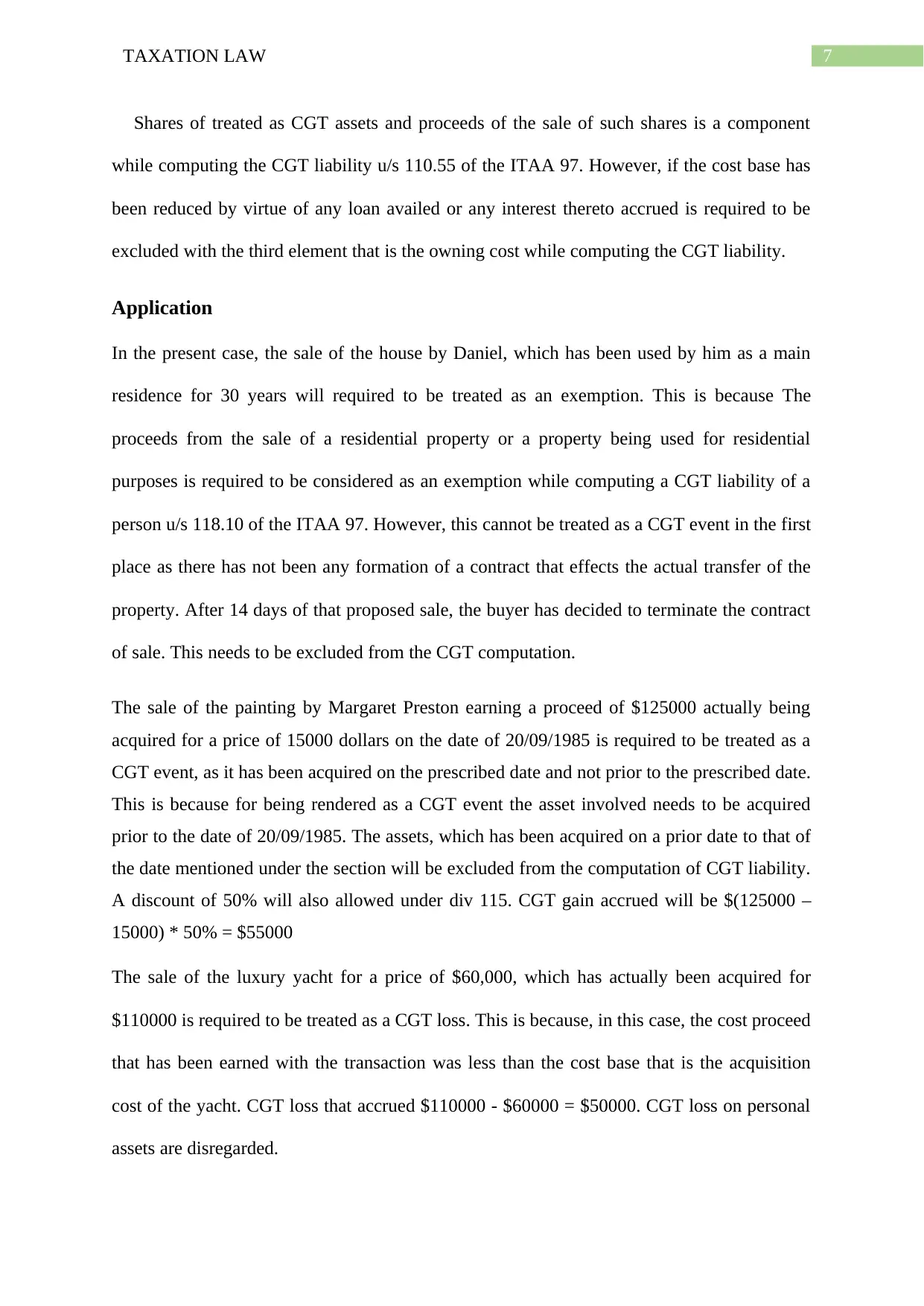
7TAXATION LAW
Shares of treated as CGT assets and proceeds of the sale of such shares is a component
while computing the CGT liability u/s 110.55 of the ITAA 97. However, if the cost base has
been reduced by virtue of any loan availed or any interest thereto accrued is required to be
excluded with the third element that is the owning cost while computing the CGT liability.
Application
In the present case, the sale of the house by Daniel, which has been used by him as a main
residence for 30 years will required to be treated as an exemption. This is because The
proceeds from the sale of a residential property or a property being used for residential
purposes is required to be considered as an exemption while computing a CGT liability of a
person u/s 118.10 of the ITAA 97. However, this cannot be treated as a CGT event in the first
place as there has not been any formation of a contract that effects the actual transfer of the
property. After 14 days of that proposed sale, the buyer has decided to terminate the contract
of sale. This needs to be excluded from the CGT computation.
The sale of the painting by Margaret Preston earning a proceed of $125000 actually being
acquired for a price of 15000 dollars on the date of 20/09/1985 is required to be treated as a
CGT event, as it has been acquired on the prescribed date and not prior to the prescribed date.
This is because for being rendered as a CGT event the asset involved needs to be acquired
prior to the date of 20/09/1985. The assets, which has been acquired on a prior date to that of
the date mentioned under the section will be excluded from the computation of CGT liability.
A discount of 50% will also allowed under div 115. CGT gain accrued will be $(125000 –
15000) * 50% = $55000
The sale of the luxury yacht for a price of $60,000, which has actually been acquired for
$110000 is required to be treated as a CGT loss. This is because, in this case, the cost proceed
that has been earned with the transaction was less than the cost base that is the acquisition
cost of the yacht. CGT loss that accrued $110000 - $60000 = $50000. CGT loss on personal
assets are disregarded.
Shares of treated as CGT assets and proceeds of the sale of such shares is a component
while computing the CGT liability u/s 110.55 of the ITAA 97. However, if the cost base has
been reduced by virtue of any loan availed or any interest thereto accrued is required to be
excluded with the third element that is the owning cost while computing the CGT liability.
Application
In the present case, the sale of the house by Daniel, which has been used by him as a main
residence for 30 years will required to be treated as an exemption. This is because The
proceeds from the sale of a residential property or a property being used for residential
purposes is required to be considered as an exemption while computing a CGT liability of a
person u/s 118.10 of the ITAA 97. However, this cannot be treated as a CGT event in the first
place as there has not been any formation of a contract that effects the actual transfer of the
property. After 14 days of that proposed sale, the buyer has decided to terminate the contract
of sale. This needs to be excluded from the CGT computation.
The sale of the painting by Margaret Preston earning a proceed of $125000 actually being
acquired for a price of 15000 dollars on the date of 20/09/1985 is required to be treated as a
CGT event, as it has been acquired on the prescribed date and not prior to the prescribed date.
This is because for being rendered as a CGT event the asset involved needs to be acquired
prior to the date of 20/09/1985. The assets, which has been acquired on a prior date to that of
the date mentioned under the section will be excluded from the computation of CGT liability.
A discount of 50% will also allowed under div 115. CGT gain accrued will be $(125000 –
15000) * 50% = $55000
The sale of the luxury yacht for a price of $60,000, which has actually been acquired for
$110000 is required to be treated as a CGT loss. This is because, in this case, the cost proceed
that has been earned with the transaction was less than the cost base that is the acquisition
cost of the yacht. CGT loss that accrued $110000 - $60000 = $50000. CGT loss on personal
assets are disregarded.
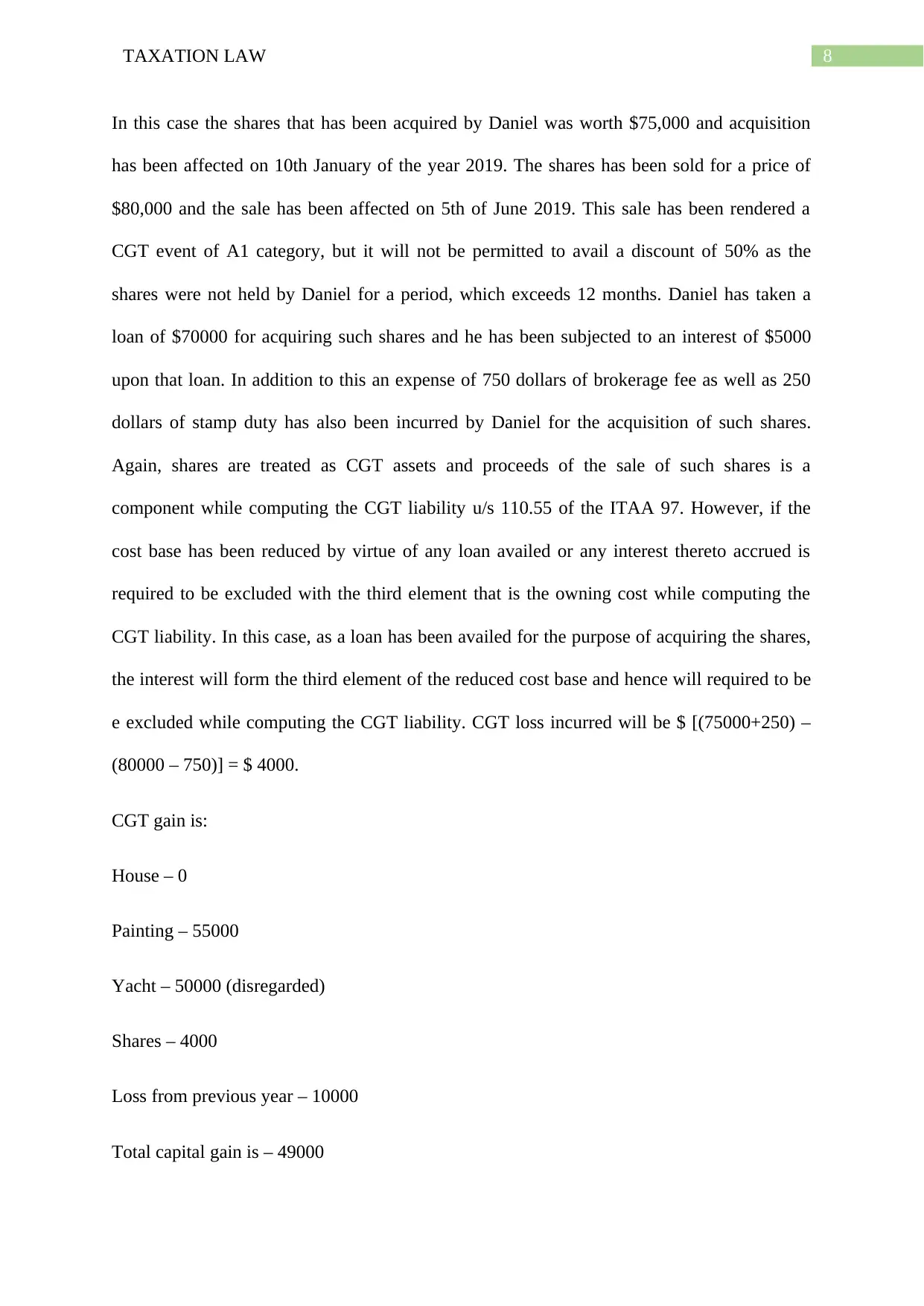
8TAXATION LAW
In this case the shares that has been acquired by Daniel was worth $75,000 and acquisition
has been affected on 10th January of the year 2019. The shares has been sold for a price of
$80,000 and the sale has been affected on 5th of June 2019. This sale has been rendered a
CGT event of A1 category, but it will not be permitted to avail a discount of 50% as the
shares were not held by Daniel for a period, which exceeds 12 months. Daniel has taken a
loan of $70000 for acquiring such shares and he has been subjected to an interest of $5000
upon that loan. In addition to this an expense of 750 dollars of brokerage fee as well as 250
dollars of stamp duty has also been incurred by Daniel for the acquisition of such shares.
Again, shares are treated as CGT assets and proceeds of the sale of such shares is a
component while computing the CGT liability u/s 110.55 of the ITAA 97. However, if the
cost base has been reduced by virtue of any loan availed or any interest thereto accrued is
required to be excluded with the third element that is the owning cost while computing the
CGT liability. In this case, as a loan has been availed for the purpose of acquiring the shares,
the interest will form the third element of the reduced cost base and hence will required to be
e excluded while computing the CGT liability. CGT loss incurred will be $ [(75000+250) –
(80000 – 750)] = $ 4000.
CGT gain is:
House – 0
Painting – 55000
Yacht – 50000 (disregarded)
Shares – 4000
Loss from previous year – 10000
Total capital gain is – 49000
In this case the shares that has been acquired by Daniel was worth $75,000 and acquisition
has been affected on 10th January of the year 2019. The shares has been sold for a price of
$80,000 and the sale has been affected on 5th of June 2019. This sale has been rendered a
CGT event of A1 category, but it will not be permitted to avail a discount of 50% as the
shares were not held by Daniel for a period, which exceeds 12 months. Daniel has taken a
loan of $70000 for acquiring such shares and he has been subjected to an interest of $5000
upon that loan. In addition to this an expense of 750 dollars of brokerage fee as well as 250
dollars of stamp duty has also been incurred by Daniel for the acquisition of such shares.
Again, shares are treated as CGT assets and proceeds of the sale of such shares is a
component while computing the CGT liability u/s 110.55 of the ITAA 97. However, if the
cost base has been reduced by virtue of any loan availed or any interest thereto accrued is
required to be excluded with the third element that is the owning cost while computing the
CGT liability. In this case, as a loan has been availed for the purpose of acquiring the shares,
the interest will form the third element of the reduced cost base and hence will required to be
e excluded while computing the CGT liability. CGT loss incurred will be $ [(75000+250) –
(80000 – 750)] = $ 4000.
CGT gain is:
House – 0
Painting – 55000
Yacht – 50000 (disregarded)
Shares – 4000
Loss from previous year – 10000
Total capital gain is – 49000
⊘ This is a preview!⊘
Do you want full access?
Subscribe today to unlock all pages.

Trusted by 1+ million students worldwide
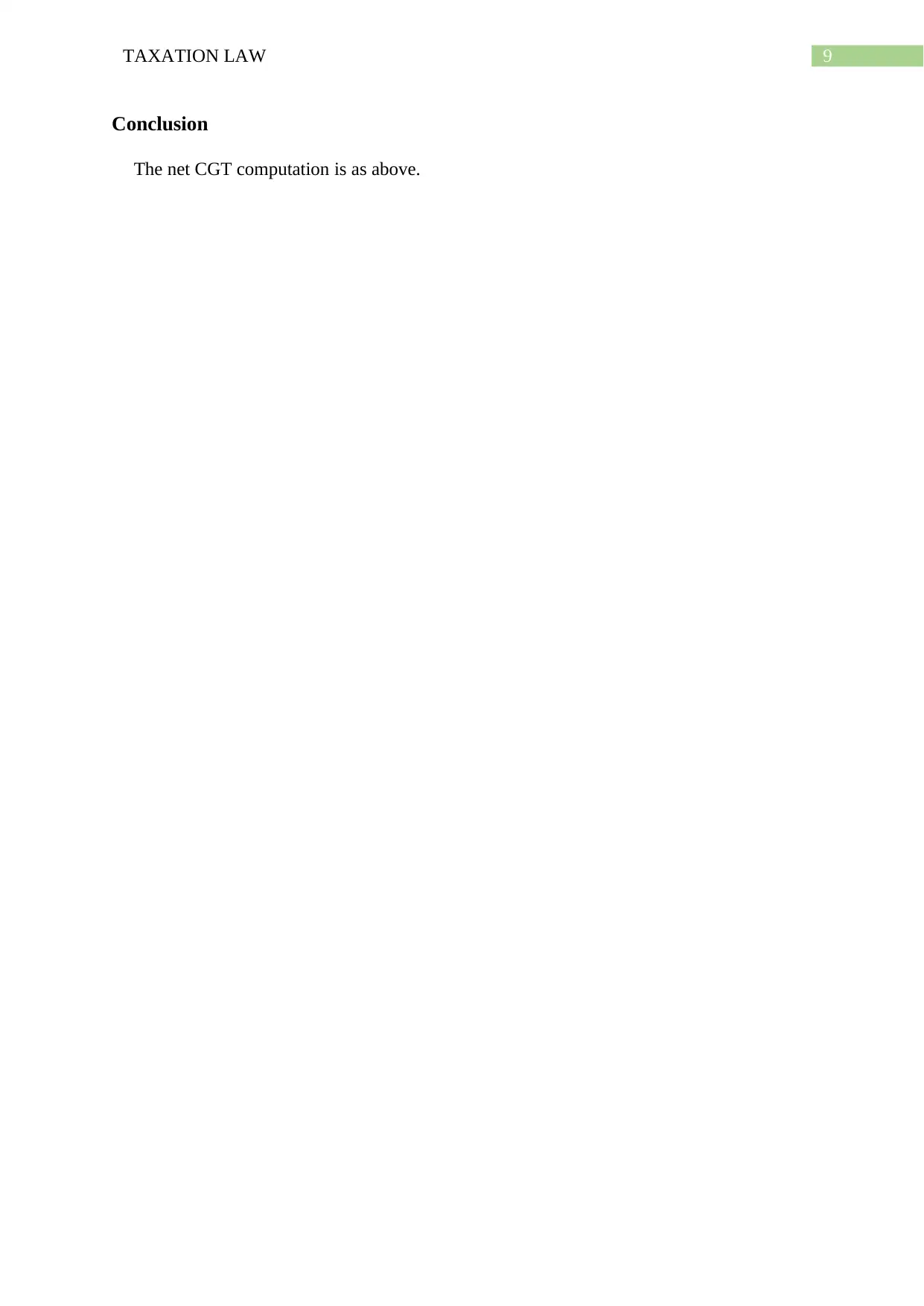
9TAXATION LAW
Conclusion
The net CGT computation is as above.
Conclusion
The net CGT computation is as above.
Paraphrase This Document
Need a fresh take? Get an instant paraphrase of this document with our AI Paraphraser
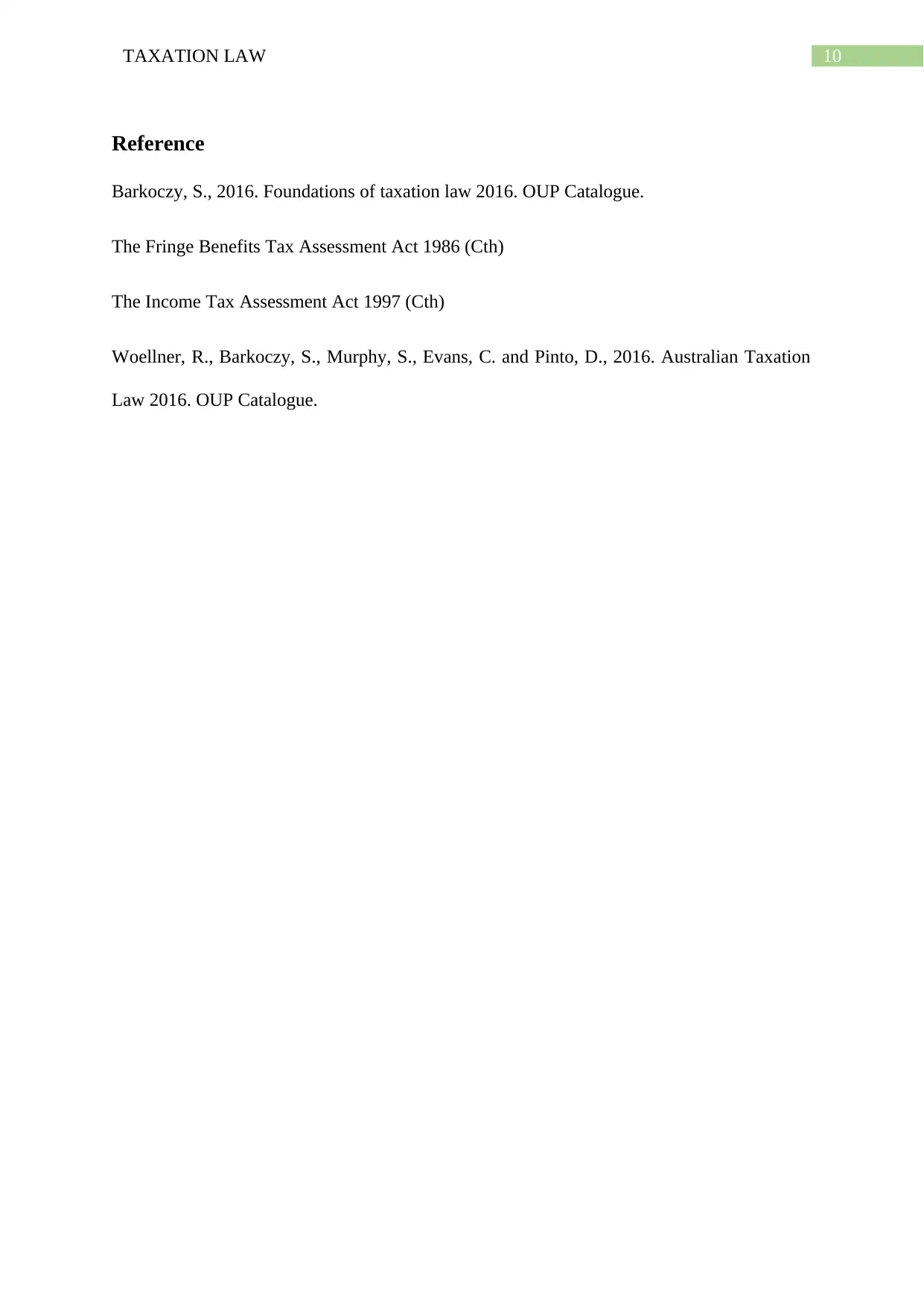
10TAXATION LAW
Reference
Barkoczy, S., 2016. Foundations of taxation law 2016. OUP Catalogue.
The Fringe Benefits Tax Assessment Act 1986 (Cth)
The Income Tax Assessment Act 1997 (Cth)
Woellner, R., Barkoczy, S., Murphy, S., Evans, C. and Pinto, D., 2016. Australian Taxation
Law 2016. OUP Catalogue.
Reference
Barkoczy, S., 2016. Foundations of taxation law 2016. OUP Catalogue.
The Fringe Benefits Tax Assessment Act 1986 (Cth)
The Income Tax Assessment Act 1997 (Cth)
Woellner, R., Barkoczy, S., Murphy, S., Evans, C. and Pinto, D., 2016. Australian Taxation
Law 2016. OUP Catalogue.
1 out of 11
Related Documents
Your All-in-One AI-Powered Toolkit for Academic Success.
+13062052269
info@desklib.com
Available 24*7 on WhatsApp / Email
![[object Object]](/_next/static/media/star-bottom.7253800d.svg)
Unlock your academic potential
Copyright © 2020–2025 A2Z Services. All Rights Reserved. Developed and managed by ZUCOL.




